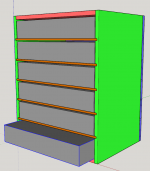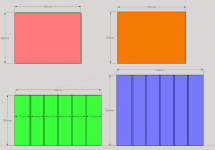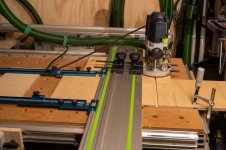Jeff Zanin
Member
- Joined
- Jan 2, 2009
- Messages
- 328
I am making a shelf for Racco parts boxes, because I have nine of them and only four will fit in the Racktainer.
The cabinet is 12mm plywood assembled with 4mm dominoes, and the shelves are 1/4" plywood - the real thing from years ago.
[attachimg=1]
[attachimg=2]
My question is how to make the grooves in the sides (green) and back (purple)? It isn't shown on the drawing but I would prefer the grooves in the back to be stopped so they don't show when the cabinet is assembled. The spacing of the grooves needs to match for the shelves to fit properly.
It seems like a table saw job - set the fence for groove 1, run all three pieces, move the fence for groove 2, run all three pieces, etc., and I could do it this way if necessary.
My preference would be to do this with a router (OF1400), but I am stuck trying to figure out a jig or other arrangement to align the parts to make the groove spacing match on all three pieces.
All suggestions gratefully received.
The cabinet is 12mm plywood assembled with 4mm dominoes, and the shelves are 1/4" plywood - the real thing from years ago.
[attachimg=1]
[attachimg=2]
My question is how to make the grooves in the sides (green) and back (purple)? It isn't shown on the drawing but I would prefer the grooves in the back to be stopped so they don't show when the cabinet is assembled. The spacing of the grooves needs to match for the shelves to fit properly.
It seems like a table saw job - set the fence for groove 1, run all three pieces, move the fence for groove 2, run all three pieces, etc., and I could do it this way if necessary.
My preference would be to do this with a router (OF1400), but I am stuck trying to figure out a jig or other arrangement to align the parts to make the groove spacing match on all three pieces.
All suggestions gratefully received.



